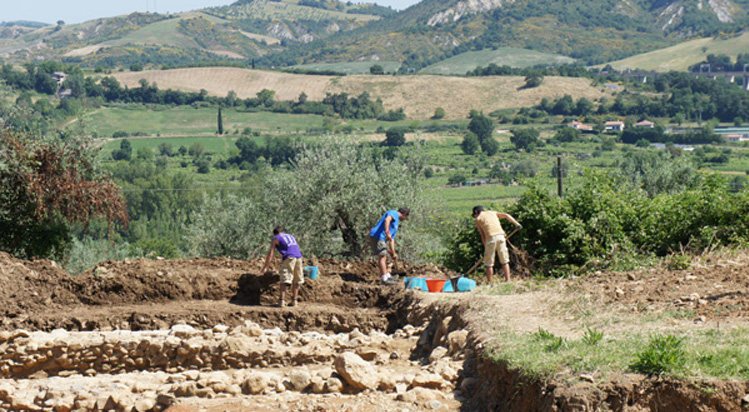projects in Italy
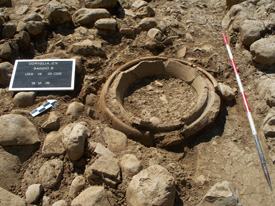
The Department of Classics directs an international archaeological project in Orvieto. The Department works in cooperation in Italy with the civic and archaeological officials of the towns of Orvieto, Castel Viscardo, Monterubiaglio, and the Soprintendenza per I Beni Archeologici dell’Umbria. This archaeological expedition is part of a long-term project to excavate several sites near Orvieto. This season we will be working at two sites: the first project is an Etrusco-Roman settlement approximately 8 miles from Orvieto, the second is a 2500 year old Etruscan pyramidal structure deep below the city of Orvieto.
CORIGLIA: At the Etrusco-Roman settlement, over the last eight years, we have uncovered a number of monumental structures. Among the most striking features are two walls (one Etruscan, the other Roman) the most recent a retaining wall of Imperial date running more or less East-West for 55m then turning to the North and apparently running for 70m. To the south of this wall runs the older Etruscan wall constructed of tufa and encased with basalt stone. The Imperial wall seems to respect the footprint of this earlier wall dated from ceramics and construction to between the 6th to the 4th century BCE. All of the ceramic materials found in this context are Etruscan or imported Greek. Behind the tufa wall seems to have been a terrace surmounted by a series of inverted large pots (dolia) referred to as ziros. In this part of Etruria, these finds frequently indicate a sacrifice to gods of the dead. If these walls mark out a temenos (sacred space), we do not know what direction if faced. We did find evidence for postholes and collapse of a structure on the terrace. An understanding of their context here requires further excavation. Further to the south of these structures we found in 2009 a large basin (vasca) cutting through at least four phases of walls. In 2014 we found two more very large basins (large enough for two cars to fit into them). These structures are of Roman Imperial date but we found 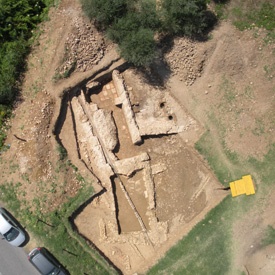 evidence for their continued use until the 14th century. Another area of particular interest is on the northwest corner of the site. In 2007 we uncovered an apsidal structure the inside of which was covered with hydraulic cement that we interpreted as either associated with a caldarium (the heated portion of a bath) or as part of a nymphaeum (a type of water feature). In 2008 we found more rooms closely to the north of the apsidal structure but neither abutting or quite in the current state of preservation adjoining. This past season we recovered another apsidal structure and remains of a hypocaust system at the far northern end of the trench but the association of the various parts to each other is as yet unclear. Unrelated to these structures we have found a series of Etruscan wall one of which had an Etruscan ritual deposit beneath it.
evidence for their continued use until the 14th century. Another area of particular interest is on the northwest corner of the site. In 2007 we uncovered an apsidal structure the inside of which was covered with hydraulic cement that we interpreted as either associated with a caldarium (the heated portion of a bath) or as part of a nymphaeum (a type of water feature). In 2008 we found more rooms closely to the north of the apsidal structure but neither abutting or quite in the current state of preservation adjoining. This past season we recovered another apsidal structure and remains of a hypocaust system at the far northern end of the trench but the association of the various parts to each other is as yet unclear. Unrelated to these structures we have found a series of Etruscan wall one of which had an Etruscan ritual deposit beneath it.
Our initial interpretation of the site was that it 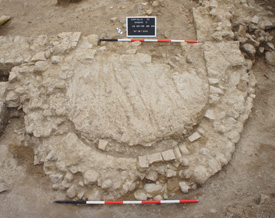 was an Etruscan settlement that, after the Roman conquest of Orvieto (the Etruscan Velzna), had developed into a Roman villa. The finds are, however, incongruous with this idea; they are too monumental in some cases and wanting in the types of ceramic remains that one would expect to find associated with a villa. In addition the roof tiles are more indicative of public and religious buildings of the Etruscan and Roman periods. Our current working model is that Coriglia begins life as an Etruscan healing shrine around which a small town develops then grows. Coriglia in turn, after the Roman suppression of Orvieto (Velzna) with which it is associated grows into a larger town with a bath complex/shrine along a branch of the Via Cassia during the late Republic. The complex remains in use until at least the 5th century CE. The settlement persists until at least 1000 CE with production activity lasting until the 15th century CE.
was an Etruscan settlement that, after the Roman conquest of Orvieto (the Etruscan Velzna), had developed into a Roman villa. The finds are, however, incongruous with this idea; they are too monumental in some cases and wanting in the types of ceramic remains that one would expect to find associated with a villa. In addition the roof tiles are more indicative of public and religious buildings of the Etruscan and Roman periods. Our current working model is that Coriglia begins life as an Etruscan healing shrine around which a small town develops then grows. Coriglia in turn, after the Roman suppression of Orvieto (Velzna) with which it is associated grows into a larger town with a bath complex/shrine along a branch of the Via Cassia during the late Republic. The complex remains in use until at least the 5th century CE. The settlement persists until at least 1000 CE with production activity lasting until the 15th century CE.
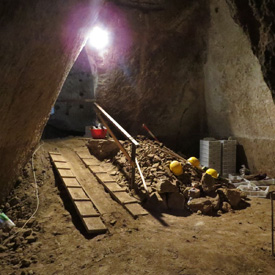 CAVITÀ 254: As for the underground pyramidal structure (hypogeum), we discovered it three summers ago and still have no idea what it is. We do know what it is not. It is not a quarry; it’s walls are too well dressed. It is not a well or cistern; its walls have no evidence of hydraulic treatments. Currently we are 15 meters down. Below a medieval floor we have a mix of material from the prehistoric to the 5th century BCE. This is followed by a meter and half of relatively sterile gray sandy material that was dumped from some point above at the center of the cavity. Below this, are a series of strata that were deposited from a point on the wall where a flight of stairs cut into the tufa descends. We are recovering material for these deposits that date to around the middle to end of the 6th century.
CAVITÀ 254: As for the underground pyramidal structure (hypogeum), we discovered it three summers ago and still have no idea what it is. We do know what it is not. It is not a quarry; it’s walls are too well dressed. It is not a well or cistern; its walls have no evidence of hydraulic treatments. Currently we are 15 meters down. Below a medieval floor we have a mix of material from the prehistoric to the 5th century BCE. This is followed by a meter and half of relatively sterile gray sandy material that was dumped from some point above at the center of the cavity. Below this, are a series of strata that were deposited from a point on the wall where a flight of stairs cut into the tufa descends. We are recovering material for these deposits that date to around the middle to end of the 6th century.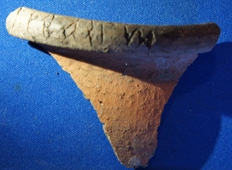 There are large quantities of Gray and Black bucchero, common ware as well as substantial Attic Red and Black Figure pottery. From this, we know that the site was sealed toward the end of the 5th century BCE. It appears to have been a single event. Of great significance is the number of Etruscan language inscriptions that we have recovered – over a hundred and fifty. We are also finding an interesting array of architectural/decorative terra cotta. Again, we do not as yet know its original function or why it was “killed”.
There are large quantities of Gray and Black bucchero, common ware as well as substantial Attic Red and Black Figure pottery. From this, we know that the site was sealed toward the end of the 5th century BCE. It appears to have been a single event. Of great significance is the number of Etruscan language inscriptions that we have recovered – over a hundred and fifty. We are also finding an interesting array of architectural/decorative terra cotta. Again, we do not as yet know its original function or why it was “killed”.
